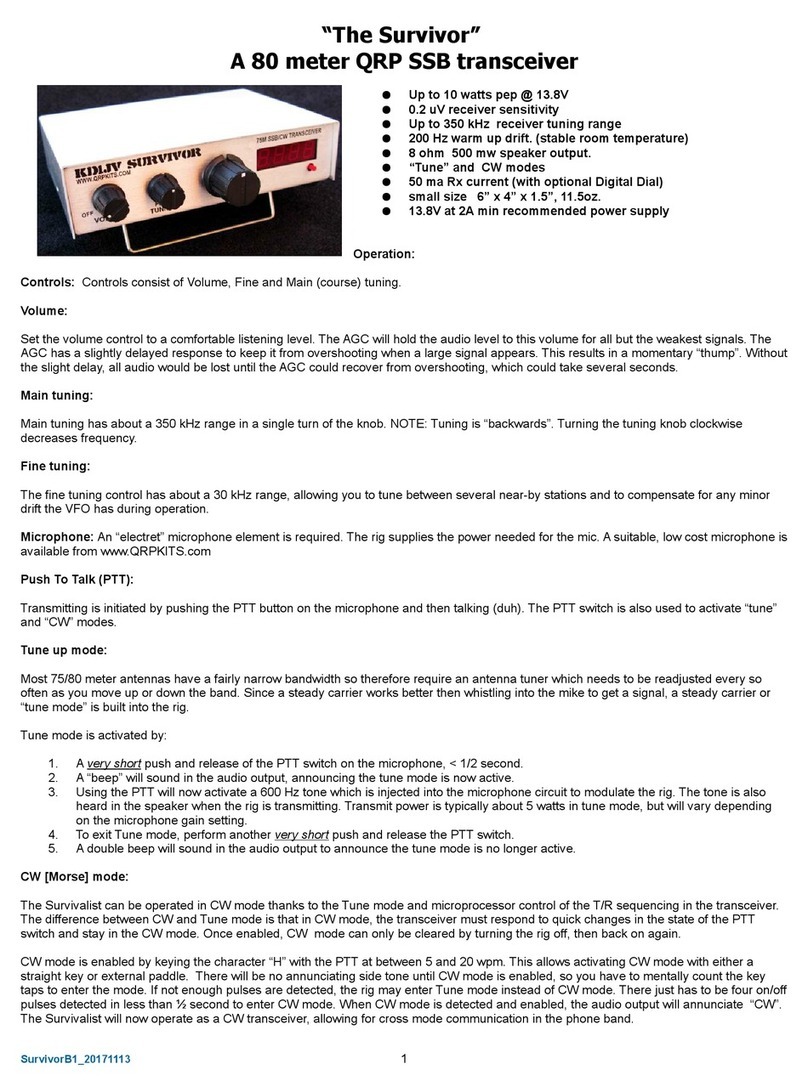
Capacitors:
There are four types of capacitors used.
●
Multi-layer (MONO) caps, which are generally yellow and rectangular is shape.
●
NPO type disks will have a black dot on the top edge of the cap. Note. Some of the ceramic disk caps will have lead spacing wider
then the hole spacing on the board. In this case, use your needle nose pliers to kink both leads inward slightly to match the board
hole spacing.
●
Film capacitors. These will be green in color.
●
Aluminum Electrolytic. These are round cylinders and have polarity. They must be installed with the correct polarity. Electrolytic
caps inserted with the wrong polarity across the DC supply can heat up and explode! The negative lead is marked with a black
stripe and the positive lead is always the longer lead.
Capacitor value markings:
The capacitor value is marked on the part with a two or three digit number and is read in picofards. The third digit is the zero multiplier.
Values of less than 100 pfd generally show only two digits, but sometimes three. Therefore, if a part is marked 470, that means it is a 47 pfd
cap and not a 470 pfd cap. A 470 pfd cap would be marked 471. Mono caps also often have letters printed on the part. These letters
indicate the type or tolerance and can be disregarded.
NOTE: Although the electrolytic caps are listed in the table below, they should be installed last.
√location value type √location value type
C1 BAND SPEC SEE BAND TABLE
C23 0.1 ufd (104) MONO, YELLOW
C2 0.1 ufd (104) MONO, YELLOW
C24 100 pfd (101) NPO DISK, OR MONO YELLOW
C3 0.1 ufd (104) MONO, YELLOW
C25 2.2 pfd (2.2) NPO DISK, BROWN
C4 100 ufd /16 or 25V ELECTOLYTIC
C26 2.2 pfd (2.2) NPO DISK, BROWN
C5 100 ufd /16 or 25V ELECTOLYTIC
C27 0.1 ufd (104) MONO, YELLOW
C6 BAND SPEC SEE BAND TABLE
C28 22 pfd (22) NPO DISK, BROWN
C7 BAND SPEC SEE BAND TABLE
C29 47 pfd (47) NPO DISK, BROWN
C8 BAND SPEC SEE BAND TABLE
C30 22 pfd (22) NPO DISK, BROWN
C9 0.1 ufd (104) MONO, YELLOW
C31 0.1 ufd (104) MONO, YELLOW
C10 0.01 ufd (103) FILM, GREEN
C32 100 pfd (101) NPO DISK, OR MONO YELLOW
C11 BAND SPEC SEE BAND TABLE
C33 10 ufd /16 or 25V
ELECTROLYTIC
C12 BAND SPEC SEE BAND TABLE
C34 100 pfd (101) NPO DISK, BROWN
C13 BAND SPEC SEE BAND TABLE
C35 100 pfd (101) NPO DISK, OR MONO YELLOW
C14 0.1 ufd (104) MONO, YELLOW
C36 0.1 ufd (104) MONO, YELLOW
C15 0.1 ufd (104) MONO, YELLOW
C37 100 pfd (101) NPO DISK, OR MONO YELLOW
C16 BAND SPEC SEE BAND TABLE
C38 100 pfd (101) NPO DISK, OR MONO YELLOW
C17 0.1 ufd (104) MONO, YELLOW
C39 100 pfd (101) NPO DISK, OR MONO YELLOW
C18 22 pfd (22) DISK
C40 100 pfd (101) NPO DISK, OR MONO YELLOW
C19 BAND SPEC SEE BAND TABLE
C41 .1ufd SMT PREINSTALLED
C20 BAND SPEC SEE BAND TABLE
C42 .01 ufd SMT PREINSTALLED
C21 BAND SPEC SEE BAND TABLE
C43 .01 ufd SMT, PREINSTALLED
C22 BAND SPEC SEE BAND TABLE
C44 22 pfd SMT, PREINSTALLED
C45 .01 ufd SMT, PREINSTALLED
C58 0.1 ufd (104) MONO, YELLOW
C46 100 ufd/16 or 25V ELECTROLYTIC
C59 .001 ufd (102) DISK, BROWN
































